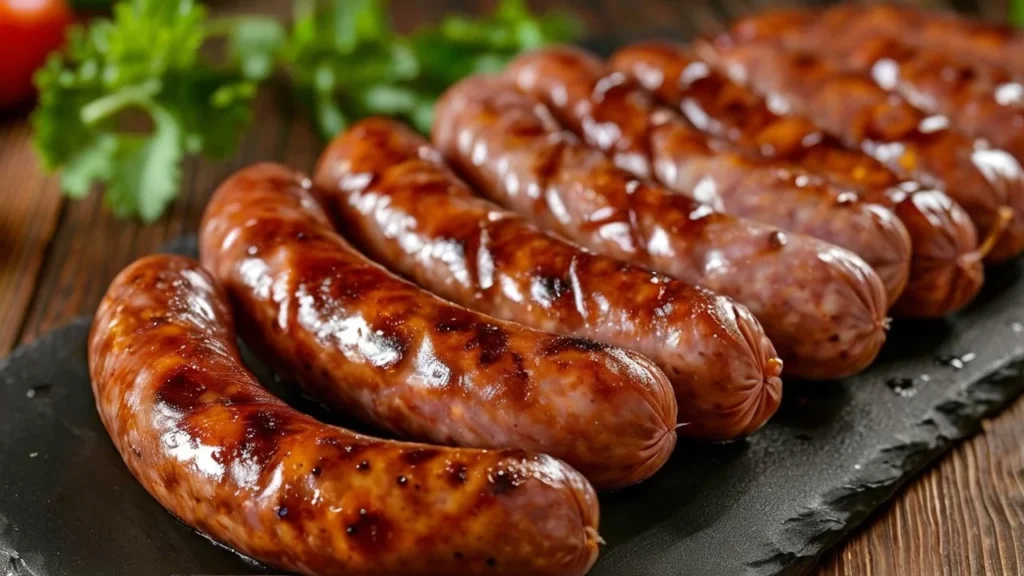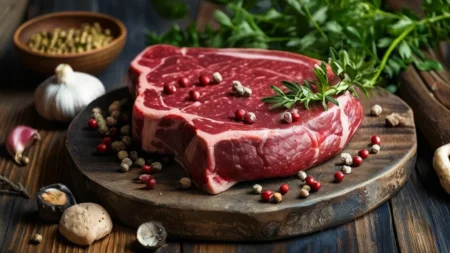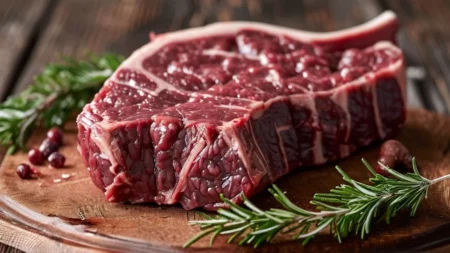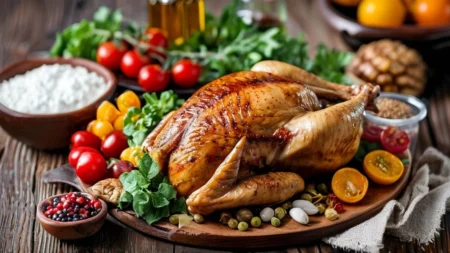Sausage: A Flavorful Addition to Your Culinary Repertoire
Key Takeaways:
- Sausages are versatile and can be made from various types of meat, including pork, beef, chicken, and turkey, as well as plant-based alternatives.
- They come in different forms, including fresh, smoked, and dried, offering a wide range of flavors and textures.
- Sausages can be a good source of protein but may also contain high levels of fat and sodium, making it important to choose wisely and enjoy in moderation.

Nutritional Profile of Sausage
The nutritional content of sausage can vary widely depending on the type of meat used, preparation methods, and any additional ingredients. Below is a general breakdown of the nutritional values per 100 grams of cooked pork sausage:
| Nutrient | Amount |
|---|---|
| Calories | 300 kcal |
| Protein | 12-16 grams |
| Total Fat | 25-28 grams |
| Saturated Fat | 9-12 grams |
| Cholesterol | 70 mg |
| Sodium | 800-1000 mg |
| Iron | 1.4 mg (8% DV) |
| Zinc | 2.7 mg (25% DV) |
| Vitamin B12 | 1.2 mcg (50% DV) |
| Phosphorus | 180 mg (25% DV) |
Protein Source
Sausages are primarily made from meat, making them a rich source of protein. However, the exact protein content can vary based on the type of sausage and its fat content.
High in Fat
Sausages can be high in fat, particularly saturated fat, which can contribute to heart disease if consumed in excess. It’s essential to consider portion sizes and choose leaner options when available.
Sodium Content
Many commercially prepared sausages contain high levels of sodium, which can impact blood pressure and overall health. It’s advisable to opt for lower-sodium varieties when possible.
Types of Sausage
Sausages come in a variety of types, each with unique flavors and preparation methods:
| Type of Sausage | Description |
|---|---|
| Fresh Sausage | Uncooked sausage made from ground meat and spices. Requires cooking before consumption. |
| Smoked Sausage | Sausages that have been smoked for flavor. Can be eaten cooked or heated. |
| Dried Sausage | Fermented and air-dried sausages, such as salami, that are safe to eat without cooking. |
| Breakfast Sausage | Typically made from pork and seasoned with herbs and spices. Often served at breakfast. |
| Italian Sausage | Flavorful sausage, usually seasoned with fennel or anise, commonly used in pasta dishes and sandwiches. |
| Bratwurst | A German sausage made from pork, beef, or veal, often grilled or pan-fried. |
Health Benefits and Considerations
While sausages can be a tasty addition to many dishes, it’s important to be mindful of their nutritional implications:
1. Protein-Rich
Sausages can provide a significant amount of protein, which is essential for muscle repair and growth, making them a good option for active individuals.
2. Source of B Vitamins
Sausages are often rich in B vitamins, particularly B12, which is crucial for energy production and maintaining healthy nerve function.
3. Enjoy in Moderation
Due to the high fat and sodium content in many sausages, it’s important to consume them in moderation and choose healthier options when possible. Look for leaner meats and reduced-sodium versions.
How to Cook Sausage
Cooking sausage can be done in several ways, each yielding different textures and flavors. Here are some popular methods:
1. Grilling
Grilling sausages adds a smoky flavor and crisp texture. Preheat the grill, cook over medium heat for about 15-20 minutes, turning frequently to ensure even cooking.
2. Pan-Frying
Pan-frying sausages in a skillet allows for crispy exteriors. Heat a small amount of oil in the pan, add the sausages, and cook for about 10-15 minutes over medium heat, turning regularly.
3. Baking
Baking sausages is a healthier method that requires no additional fat. Preheat the oven to 400°F (200°C) and bake the sausages for about 20-25 minutes, turning halfway through.
4. Boiling
Boiling sausages before grilling or frying can help ensure they are cooked through. Simmer in water for 10-15 minutes, then finish on the grill or in a pan for added flavor.
Popular Sausage Dishes
Sausages can be incorporated into a variety of dishes, enhancing flavors and providing protein:
| Dish | Description |
|---|---|
| Sausage Pasta | A hearty dish made with pasta, sausages, vegetables, and sauce. |
| Sausage Pizza | Topped with sausage, cheese, and various toppings for a delicious meal. |
| Breakfast Hash | Sausages combined with potatoes, eggs, and vegetables for a filling breakfast. |
| Sausage and Peppers | A classic dish featuring sautéed sausages with bell peppers and onions, served on a roll or over rice. |
| Sausage Soup | A comforting soup made with sausages, vegetables, and broth. |
Choosing Healthy Sausage Options
When selecting sausages, consider the following tips to make healthier choices:
1. Look for Lean Cuts
Choose sausages made from leaner meats, such as chicken or turkey, which typically contain less fat than pork or beef options.
2. Check Sodium Content
Select lower-sodium sausages to help manage blood pressure and reduce sodium intake.
3. Read Ingredient Labels
Opt for sausages with minimal additives and preservatives. Whole food ingredients are generally healthier.
Conclusion
Sausages are a delicious and versatile food that can be enjoyed in many dishes. While they can provide valuable protein and essential vitamins, it’s important to be mindful of their fat and sodium content. By choosing healthier options and enjoying sausages in moderation, they can be a flavorful addition to a balanced diet.
FAQ
Q: Are sausages unhealthy?
A: Sausages can be part of a healthy diet when consumed in moderation and when choosing leaner, lower-sodium options.
Q: How do I know when sausage is cooked?
A: Cooked sausage should have an internal temperature of at least 160°F (71°C) for pork and beef, and 165°F (74°C) for poultry.
Q: Can I freeze sausages?
A: Yes, sausages can be frozen. Store them in airtight packaging, and they can last for up to six months in the freezer.
Q: What are some good sausage substitutes?
A: Alternatives to traditional sausage include turkey sausage, chicken sausage, or plant-based sausage options made from tofu or vegetables.
Q: Can I cook sausages from frozen?
A: Yes, sausages can be cooked from frozen, but it will take longer. Ensure they reach the appropriate internal temperature.










